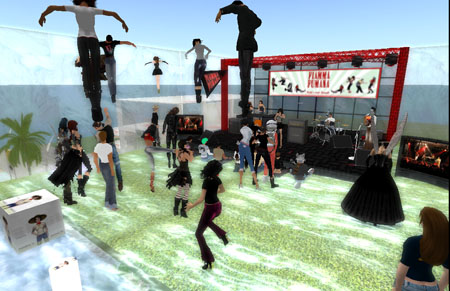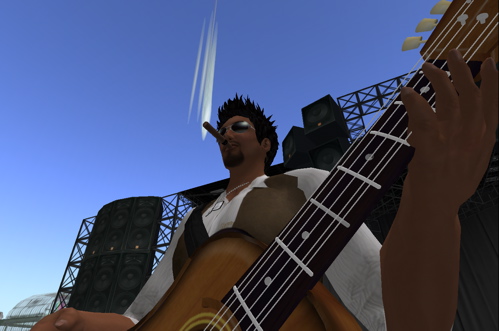
Once we had dealt with the technical issues both inworld (build acceptable avatars, find instruments and animations, build the stage…) and in RL (organize the signal channel from our RL instruments to the streaming server), yesterday’s concert in Second Life was emotional and fun. We “felt” the audience, it felt “like being there”. The vibe is more or less that of a live-on-the-radio performance, maybe more fun because you can actually see the audience and interact with them. It was a success, too: we had a full sim and everyone was happy with the experience.
I thought I’d share here the solution we found to do a “real” live show (not just streaming of prerecorded audio files, as most people do in SL). Here it is:
- the band gathered in a recording studio (Casamedusa in Milan), The signal from the studio main board was routed to a USB audio interface connected to a PC on which WinAmp and Shoutcast DSP (a WinAmp plugin for audio streaming) had been installed.
- we bought time on a SL-specialized streaming service based on Shoutcast. You pay according to time and number of people served: we bought 24 hours for 50 avatars for 700 Lindens. When you pay, the service gives you the config parameters for both Shoutcast DSP and the SL land (which needs to read the music stream from that server’s feed). The sound quality was found to be quite good.
- our avatars were steered by other people, leaving us free to concentrate on the music. We, however, had chosen animations, instruments etc.
- In the performance room, standing net to us, we set up a laptop logged into SL (via the studio wi-fi) as a “spectator” avatar, allowing us to see the audience inworld and interact with it. (“Hey, you really are raving like there’s no tomorrow! Let’s all fly around the stage!”). The ADSL can take the audio streaming plus one logged-in avatar no problem.
- in the control room of the studio there was Ginevra with another laptop (this one logged onto the net via UMTS, in order not to burden the bandwidth) logged onto SL with our vocalist Roberta’s avatar. Besides animating it, she was charged with monitoring the inworld audio and reporting any problems to the engineer.
What I think we should try and improve is interacting with the audience. We’d need a much bigger screen in the studio to have a better feeling of what happens inworld; also we need to learn to interact in the presence of significant streaming latency. Setting DSP to the same parameters as the server (128 kps, 44.1 KHz, mono) we had about 15 seconds latency: that is to say, a note we played in RL would be heard inworld 15 secs later. This means that we could not communicate by talking and responding, but only trying to steer the emotion f the performance: warmup first, then full power on, then slow at the very end.
Roberta was great in mixing SL lingo and live concert ritual (“Are you having find, my dear newbies? LOL!”) and the audience really dug it. Except at the end, when we played a solemn, atmospheric Bella Ciao and everyone was still running wild dancing anims. We all need to learn…
Francesco, Velas, Emiliano, Junikiro, Joey, Rosa, Ginevra, Eliver, Tonino, Asian e tutti i volontari della Festa.
